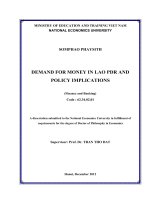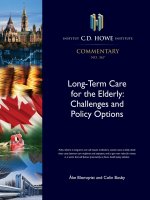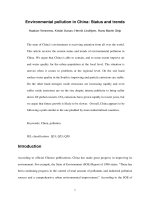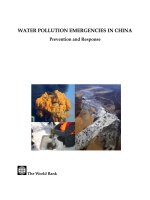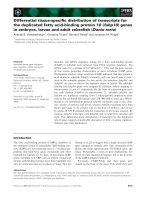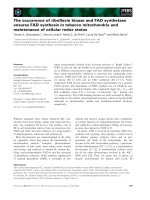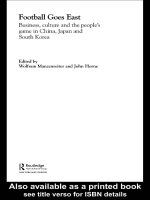Reducing Inequality For Shared Growth In China - Strategy And Policy Options For Guangdong Province docx
Bạn đang xem bản rút gọn của tài liệu. Xem và tải ngay bản đầy đủ của tài liệu tại đây (5.33 MB, 396 trang )
Reducing Inequality for
Shared Growth in China
Strategy and Policy Options for
Guangdong Province
DIRECTIONS IN DEVELOPMENT
Human Development
Public Disclosure AuthorizedPublic Disclosure AuthorizedPublic Disclosure AuthorizedPublic Disclosure Authorized
58846
Reducing Inequality for Shared
Growth in China
Reducing Inequality for
Shared Growth in China
Strategy and Policy Options for
Guangdong Province
© 2011 The International Bank for Reconstruction and Development / The World Bank
1818 H Street NW
Washington DC 20433
Telephone: 202-473-1000
Internet: www.worldbank.org
All rights reserved
1 2 3 4 13 12 11 10
This volume is a product of the staff of the International Bank for Reconstruction and
Development / The World Bank. The findings, interpretations, and conclusions expressed in this
volume do not necessarily reflect the views of the Executive Directors of The World Bank or the
governments they represent.
The World Bank does not guarantee the accuracy of the data included in this work. The bound-
aries, colors, denominations, and other information shown on any map in this work do not imply
any judgement on the part of The World Bank concerning the legal status of any territory or the
endorsement or acceptance of such boundaries.
Rights and Permissions
The material in this publication is copyrighted. Copying and/or transmitting portions or all of
this work without permission may be a violation of applicable law. The International Bank for
Reconstruction and Development / The World Bank encourages dissemination of its work and
will normally grant permission to reproduce portions of the work promptly.
For permission to photocopy or reprint any part of this work, please send a request with com-
plete information to the Copyright Clearance Center Inc., 222 Rosewood Drive, Danvers, MA
01923, USA; telephone: 978-750-8400; fax: 978-750-4470; Internet: www.copyright.com.
All other queries on rights and licenses, including subsidiary rights, should be addressed to the
Office of the Publisher, The World Bank, 1818 H Street NW, Washington, DC 20433, USA;
fax: 202-522-2422; e-mail:
ISBN: 978-0-8213-8484-8
eISBN: 978-0-8213-8501-2
DOI: 10.1596/978-0-8213-8484-8
Library of Congress Cataloging-in-Publication Data
Reducing inequality for shared growth in China : strategy and policy options for Guangdong
province.
p. cm.
Includes bibliographical references and index.
ISBN 978-0-8213-8484-8 — ISBN 978-0-8213-8501-2 (electronic)
1. Guangdong Sheng (China)—Social conditions—21st century. 2. Guangdong Sheng
(China)—Social policy. 3. Guangdong Sheng (China)—Social planning. 4. City planning—
China—Guangdong Sheng. 5. Education—China—Guangdong Sheng. 6. Social change—
China—Guangdong Sheng. 7. Guangdong Sheng (China)—Politics and government—21st
century. I. World Bank.
HN740.G83R43 2010
307.3
'4095127—dc22
2010030042
Cover photo: Panorama Media Limited
Cover design: Naylor Design, Washington, DC
v
Foreword by Wang Yang xvii
Foreword by James W. Adams xxiii
Acknowledgments xxvii
Abbreviations xxix
Overview 1
Background of Guangdong Province 3
The Challenge of Inequality in Guangdong 4
Reducing Inequality with Spatially Unbalanced
Growth 10
Reducing Inequality: A Three-Pillar Strategy 12
Eliminating Absolute Poverty through the
Dibao System 15
Boosting Rural Income by Giving People
Opportunities 18
Investing in People through More
Equitable Service Delivery 29
Conclusion 39
Notes 41
References 42
Contents
Chapter 1 Understanding Poverty and Inequality
in Guangdong 45
Measuring Poverty in Guangdong 49
The Current Poverty Situation in Guangdong 53
Profile of the Poor 62
Inequality in Guangdong 65
Summary and Policy Implications 74
Notes 76
References 76
Chapter 2 Supporting the Poor through Rural Dibao 79
How to Evaluate a Social Assistance Program 81
Evolution and Main Policy Features of Rural
Dibao in Guangdong 83
Challenges Faced by the Dibao Program
in Guangdong 86
Building a Dibao Program for the Future:
Policy Recommendations 98
Notes 102
References 102
Chapter 3 Developing an Efficient and Integrated
Labor Market in Guangdong Province 103
Labor Market Overview 106
Barriers to a Mobile and Flexible Labor Market 116
Policy Implications 120
Notes 124
References 124
Chapter 4 Making Finance Work in Reducing Inequality
and Poverty in Guangdong 127
The Current Situation 131
Issues and Problems 147
Conclusions and Summary of Recommendations 157
Annex 4.1 Comparison of the Regulation
Framework for Commercial Banks and
Rural Financial Institutions, 2008 162
Annex 4.2 Different Requirements for
Microloan Companies by Central versus
Local Authorities 164
vi Contents
Annex 4.3 Innovative MSE Lending Project
in China 168
Annex 4.4 Mutual Societies in Poor Villages 170
Notes 171
References 171
Chapter 5 Guangdong: Reforming Land Policy for
Better Rights Protection and a Healthier
Development Pattern 173
A New Platform for Pursuing Bolder Innovations 174
Conclusions 190
Notes 192
References 192
Chapter 6 Spending for Compulsory Education
in Guangdong 193
Key Outcome Gaps in Compulsory Education 195
Spending Gaps in Compulsory Education and the
New Free Compulsory Education Scheme 204
Conclusions and Policy Implications 235
Annex 6.1: Outcome Indicators in
Guangdong Province 244
Annex 6.2: Spending Indicators in
Guangdong Province 247
Notes 259
References 260
Chapter 7 Skills Development in Guangdong Province 261
Preparing for Change 264
Meeting the Challenge for Skills Development 274
Annex 7.1: Tables 287
Annex 7.2: Rural and Urban Household Surveys 296
Notes 299
References 300
Chapter 8 Reducing Regional Disparities in Health
Services in Guangdong Province: Challenges
and Options 303
The Challenge of Inequality and
Regional Disparities 305
Contents vii
Resource Mobilization and Allocation 314
Summary and Recommendations 320
Improvement of the Efficiency and Equity of
Health Protection Schemes 321
Strengthening of Health Services Delivery
Capacity in the Lagging Areas 332
Issues Needing Further Attention and
Suggestions for Further Study 340
Notes 341
References 342
Index 343
Boxes
1.1 Guangdong Rural and Urban Household
Survey Data 48
1.2 Measuring the Incidence, Depth, and Severity
of Poverty 54
1.3 Measuring Inequality 66
3.1 Measuring Inequality 105
4.1 Understanding Finance 128
4.2 The Financial Crisis Legacy in Guangdong 135
4.3 The Microlending Experiments by China
Postal Savings 147
5.1 Vietnam: Land Policy Reforms and National
Land Registration Program 177
5.2 Transferable Development Rights (TDRs) 181
5.3 The Case of Atlanta 184
5.4 Smart Growth 185
5.5 Property Tax as Good Local Tax 189
6.1 Examples of Funding Formulas in Central America 240
8.1 MA Pilot in the Yubei District of
Chongqing Municipality 331
8.2 Practice on Retention of Rural Health Workers 338
Map
O.1 The Four Regions of Guangdong Province 3
Figures
1.1 Comparison of GDP and Per Capita GDP across
China’s Provinces, 2007 46
viii Contents
1.2 GDP of Guangdong and East Asian Newly Industrialized
Economies, 2007 46
1.3 Per Capita GDP of Guangdong and East Asian
Newly Industrialized Economies, 2007 47
1.4 Ratio of Rural and Urban Incomes and Per Capita GDP 48
1.5 Comparison of National Poverty Lines 52
1.6 Urban and Rural Income Distribution in
Guangdong, 2007 56
1.7 Sensitivity to the Poverty Line in Urban and Rural
Guangdong, 2007 57
1.8 Rural Income and Consumption Growth in Guangdong
by Quintile, 2005–07 60
1.9 Comparison of Gini Indexes of Income Inequality, 2007 67
1.10 Trends in Rural-Urban Disparity: Guangdong and China 68
1.11 Lorenz Curves for Per Capita Rural and Urban
Income, 2007 69
1.12 Regional Income Disparity in Guangdong and
China, 1998–2007 69
1.13 Distribution of Regional Population and Economic
Activities in Guangdong, 2007 70
1.14 Urban-Rural Distribution of Population and Economic
Activities in Guangdong, 2007 71
1.15 Income Decomposition of Pooled Rural and Urban
Households in Guangdong, 2007 72
1.16 Sources of Urban-Rural Income Disparity 73
1.17 County-Level Income Inequality Decomposition in
Guangdong, 1998–2007 74
2.1 Regional Differences in Rural Dibao Coverage 87
2.2 Correlation between Dibao Standards and
Economic Strength, Selected Counties 89
2.3 Distribution of Rural Dibao Recipients across Income
Quintiles, 2007 91
2.4 Rural Dibao Expenditure in Guangdong
in Comparison with Other Provinces 2007 94
2.5 Financing of Rural Dibao by the Provincial and Local
Governments 96
3.1 Rural Household Income in Guangdong by
Source, 2007 104
3.2 Income Inequalities and Share of Labor
Income, 2007 105
3.3 Employment by Sector in Guangdong 107
Contents ix
3.4 Labor Allocation, 2005 and 2007 108
3.5 Regional Employment Structure, 2000 and 2005 116
3.6 Average Minimum Wage Standards in Guangdong
and China 119
4.1 L/D Ratio of Financial Institutions in Urban and
Rural Areas, 2007 132
4.2 L/D Ratio of Selected Financial Institutions, 2007 133
4.3 NPL Ratio of Financial Institutions, 2007 134
4.4 NPL Ratio of Five Largest Banks, ABC, and
RCC, 2007 134
4.5 Rural Households with Access to Bank Loans, 2007 137
4.6 Rural Households with Access to Informal
and Formal Channels, 2007 137
4.7 Small Businesses with Access to Banks Loans, 2007 138
4.8 Farming Households with Access to Savings
Deposit Accounts, 2002 139
4.9 Farming Households with Access to Savings Deposit
Accounts, PRD Area vs. Non-PRD Area, 2007 140
4.10 Average Holdings of PSB Banking Cards, 2006 140
4.11 Average Holdings of Deposit Accounts, 2006 141
4.12 Number of Bank Branches in Selected Countries 142
4.13 Number of Bank Branches in Selected Countries 142
4.14 Number of Bank Branches, 2007 143
4.15 Number of Bank Branches, 2007 143
4.16 Average Number of Banking Outlets Per
Township, 2007 144
4.17 Average Number of Banking Outlets Per
Administrative Village, 2007 144
4.18 Number of Bank Branches, PRD Area vs. Non-PRD
Area, 2007 145
4.19 Number of Bank Branches, PRD Area vs. Non-PRD
Area, 2007 145
4.20 Proportion of Rural Household Loans, 2007 152
4.21 Proportion of Loans on Agricultural Production, 2007 153
6.1 The Four Gaps of Rural and Lagging Compulsory
Education 194
6.2 Gross and Net Enrollment Rates in Primary Education,
1995–2006 197
6.3 Educational Attainment of Different Age
Cohorts, 2007 198
xContents
6.4 International Comparisons of Urban and Rural
Educational Attainment among Young Populations 199
6.5 Educational Attainment for 25–35 Age Cohort in
Urban and Rural Areas, 2007 200
6.6 Educational Attainment for 25–35 Age Cohort
by Income Quintile, 2007 201
6.7 Educational Attainment for 25–35 Age Cohort by
Urban and Rural Areas and Income Quintile, 2007 201
6.8 Educational Attainment across Selected City
Areas Ranked by GDP Per Capita, 2007 202
6.9 Educational Attainment for Two City Areas and
across Urban-Rural Areas, 2007 203
6.10 Primary Education Expenditure Sources,
2004 and 2007 208
6.11 Junior Secondary Education Expenditure Sources,
2004 and 2007 208
6.12 Public Education Expenditure Indicators in Guangdong
Province and a Sample of Countries, 2004 209
6.13 Primary Education Spending and Revenue Per
Student across Rural and Urban Areas in
Guangdong Province, 2004 and 2007 213
6.14 Junior Secondary Education Spending and Revenue
Per Student across Rural and Urban Areas in
Guangdong, 2004 and 2007 214
6.15 Primary Education Revenue Per Student across
Rural and Urban Areas in Gansu Province, 2006 215
6.16 Teachers’ Salaries Per Student in Primary Education
in Urban and Rural Areas, 2004 and 2007 216
6.17 Rural Enrollment Share in Compulsory Education,
2004 and 2007 217
6.18 Gross and Net Enrollment Rates in Rural Areas,
2005 and 2007 218
6.19 New FCE Scheme and TEOS for Primary
Education per Student, 2006 and 2007 219
6.20 New FCE Scheme and TEOS for Junior Secondary
Education per Student, 2006 and 2007 220
6.21 Subsidy for Miscellaneous Fees and Budgetary
Revenues in Rural Areas, 2007 221
6.22 Miscellaneous Fees and Subsidies for Fees in
Rural Areas 221
Contents xi
6.23 Books Per Student and Ratio of Dilapidated
Buildings Overall and in Urban and Rural Areas,
2004 and 2007 222
6.24 O&M Per Student Overall and in Urban and Rural
Areas, 2004 and 2007 223
6.25 GDP Per Capita and Share of Provincial Population
of County Sample 224
6.26 Change between 2004 and 2007 in Spending and
Revenue Sources in Primary Education for the
County Sample, Yuan Per Student 226
6.27 Relationship between GDP Per Capita and Primary
Spending Per Student, 2004 227
6.28 Relationship between GDP Per Capita and Primary
Spending Per Student, 2007 227
6.29 Relationship between GDP Per Capita in 2004
and Percentage Increase in Spending Per Student 227
6.30 Relationship between GDP Per Capita in 2004 and
Percentage Increase in Budgetary Revenues Per Student 228
6.31 Decrease in Miscellaneous Fees, Fee Gap, and Change
in Rural Enrollment in Primary, Yuan Per Student 229
6.32 Relationship between GDP Per Capita and Junior
Secondary Spending Per Student, 2004 231
6.33 Relationship between GDP Per Capita and
Junior Secondary Spending Per Student, 2007 231
6.34 Relationship between GDP Per Capita in 2004
and Percentage Increase in Spending Per Student 231
6.35 Relationship between GDP Per Capita in 2004 and
Percentage Increase in Budgetary Revenues Per Student 232
6.36 Decrease in Miscellaneous Fees, Fee Gap, and
Change in Rural Enrollment in Junior Secondary,
Yuan Per Student 232
6.37 Allocation of the FCE Scheme across the Different
Subsidies in the County Sample
(Primary Education), 2007 233
6.38 Ratio of Dilapidated Primary School Buildings in
the County Sample, 2004 and 2007 234
6.39 O&M by Student for Guangdong and in the County
Sample, 2007 235
6.40 Primary Urban-Rural Spending Gaps under
Different Scenarios 238
xii Contents
6.41 Junior Secondary Urban-Rural Spending Gaps
under Different Scenarios 238
7.1 Items Ranked as First- or Second-Most Important
Constraint to Growth by ICA Firms 265
7.2 Local Government Spending on Education Per Student,
2000–06 266
7.3 Lower Per Capita Government Spending in Cities
with Large Rural Populations 269
7.4 Rise in Share of the Population Enrolled in a
Secondary School with Rise in Urban Share of a
City’s Population 270
7.5 Youth-to-Adult Unemployment Ratio and Percentage
of Senior Secondary Vocational Enrollment in OECD
Countries, 2005 272
7.6 Large Firms in Guangdong More Likely to Train
than Smaller Firms 273
7.7 Firms with an Educated Workforce More Likely
to Train 274
8.1 Per Capita GDP by Region, 2006 306
8.2 Infant Mortality Rate, 2007 306
8.3 Changes in Infant Mortality Rates, 2000–07 307
8.4 Access to Safe Drinking Water, 2007 308
8.5 Hospital Delivery Rates, 2007 309
8.6 Outpatient Visits Per Capita, 2007 309
8.7 Inpatient Services Per Capita, 2007 310
8.8 Average Per Capita Health Expenditure by Income
Quintile and Urban-Rural Difference, 2007 311
8.9 Physician Density across Municipalities and
Regions, 2007 312
8.10 Quality of Health Workers across Municipalities
and Regions, 2007 313
8.11 Government Health Spending as a Percentage of
Total Government Expenditure, 2006 317
8.12 Per Capita Government Health Spending, 2006 317
8.13 Where Need Is Greater, Resources Are Less 318
8.14 Enrollment Rate for NRCMS 322
8.15 Regional Disparity in Per Capita NRCMS
Contributions, 2007 323
8.16 Illustration of Higher-Level Pooling of the NRCMS 325
8.17 Accumulated Savings of NRCMS Revenue, 2007 326
Contents xiii
8.18 Per Capita MA Assistance across Provinces, 2007 328
8.19 Education of the Village Doctors of Guangdong 334
Tables
O.1 Decomposition of Income Inequality in Guangdong
Province, 2007 10
1.1 Poverty Lines in China 50
1.2 Comparison of National Poverty Lines in East Asia,
Selected Countries 53
1.3 Poverty Headcount, Depth, and Severity in Guangdong,
2007 ($2-Per-Day Poverty Line) 55
1.4 Concentration of Rural Poverty in Guangdong
($2-Per-Day Poverty Line) 57
1.5 Concentration of Urban Poverty in Guangdong
($2-Per-Day Poverty Line) 58
1.6 Rural Poverty by Geographic Topography, 2007
($2-Per-Day Poverty Line) 59
1.7 Rural Poverty Dynamics in Guangdong
($2-Per-Day Poverty Line) 60
1.8 Rural Income Mobility by Quintile, 2005–07 61
1.9 International Comparison of Poverty, 2005
($2-Per-Day Poverty Line) 62
1.10 Profile of Household Poverty in Rural Guangdong,
2007 ($2-Per-Day Poverty Line) 63
1.11 Profile of Individual Poverty in Rural Guangdong,
2007 ($2-per-day Poverty Line) 64
2.1 Poverty Rate and Distribution in Rural Guangdong,
2007 ($2-Per-Day Poverty Line) 80
2.2 Basic Indicators for Rural Dibao in Guangdong 84
2.3 Rural Dibao Coverage Rates vs. Rural Poverty
Rates, 2007 87
2.4 Dibao Standard and Rural Net Income, 2007 88
2.5 Comparison of Dibao Standard and Poverty Lines,
2007 89
3.1 Labor Allocation by Region, 2007 107
3.2 Change in Determinants of Labor Allocation 109
3.3 Working Time Allocation by Group, 2007 110
3.4 A New Estimation of Surplus Labor in Rural
Guangdong, 2007 112
3.5 Economic Structure and Employment 113
xiv Contents
3.6 Distribution of Employment by Locality, 2005 114
6.1 Gross and Net Enrollment Rates in Primary and
Junior Secondary Education, Administrative Data 196
6.2 Internal Efficiency Indicators, Administrative Data 196
6.3 Education Expenditure Indicators in Guangdong
Province, 2004 and 2007 205
6.4 Primary Education Expenditure Trends and Uses 206
6.5 Junior Secondary Education Expenditure
Trends and Uses 206
6.6 Primary Education Expenditure Sources 207
6.7 Junior Secondary Education Expenditure Sources 207
6A.1.1 Primary Indicators by Area (City), 2006 244
6A.1.2 Education Distribution across Rural and Urban
Areas, 2005 and 2007 245
6A.1.3 Education Distribution across Income Quintiles and
Rural and Urban Areas, 2007 246
6A.1.4 Education Distribution across Regions or Cities, 2007 246
6A.2.5 Primary Education Expenditure Trends and Patterns
across Rural and Urban Areas 247
6A.2.6 Lower Secondary Education Expenditure Trends
and Patterns across Rural and Urban Areas 248
6A.2.7 Primary Education Expenditure Sources across
Rural and Urban Areas 249
6A.2.8 Junior Secondary Education Expenditure Sources
across Rural and Urban Areas 250
6A.2.9 Composition of the New FCE Scheme and TEOS,
Average Subsidies, and Distribution by Institutional
Source, 2006 252
6A.2.10 Composition of the New FCE Scheme and TEOS,
Average Subsidies and Distribution by Institutional
Source, 2007 253
6A.2.11 Spending and Revenue Sources for Primary Education
in the Seven County/City Sample 254
6A.2.12 Spending and Revenue Sources for Junior
Secondary Education in the Seven County/City
Sample 255
6A.2.13 Amount and Allocation of the Free Compulsory
Education Scheme across the Seven County Sample 256
7A.1.1 Schools, Students, and Teachers in Guangdong Province
by Level of School, 2000–07 287
Contents xv
7A.1.2 Features of Senior Vocational Schools in Guangdong
Province, 2005 289
7A.1.3 Urban Population, Local Government Expenditures,
and Per Capita GDP by City for Guangdong
Province, 2006 289
7A.1.4 Average Annual Wage of Fully Employed Staff and
Workers by Economic Sector, 2003 and 2006 290
7A.1.5 Local Government Spending on Education in
Guangdong Province, 2000–06 290
7A.1.6 Schools, Enrollment, and Full-Time Teachers by
Type of School and City, 2006 291
7A.1.7 Employees Training by Firm Size in
Guangdong Province, 2006 292
7A.1.8 Firms Training by Export Status in Guangdong
Province, 2006 292
7A.1.9 Training by Firms by Share of Employees
with a High School Education in Guangdong
Province, 2006 293
7A.1.10 Training by Firms by Share of Employees
with a University Education in Guangdong
Province, 2006 293
7A.1.11 Ranking of Most Severe Constraints to Growth
by World Bank Investment Climate Assessment
Survey, 2006 294
7A.1.12 Characteristics of Migrant Labor in Guangdong
Province, 2006 295
7A.2.13 Summary Statistics for Key Variables 296
7A.2.14 Probit Estimates of the Likelihood of
Participation in Training in Guangdong
(Merged Sample from the 2005 and 2007
Rural Household Surveys) 297
7A.2.15 Wage Regressions 298
8.1 Disparities in Facility Infrastructure of THCs 312
8.2 Government Health Spending as a Percentage of
Total Health Expenditure 316
8.3 Criteria for General Provincial Fiscal Transfer 319
8.4 MA Program Disbursement for a
Poverty-Stricken County 328
xvi Contents
xvii
To narrow the gap between the rich and the poor and to achieve common
prosperity have been a noble dream of human society for millennia; they
are also a part of the pursuit of equality and justice in various cultures and
societies. More than two thousand years ago, The Book of Rites, a Confucian
classic, already described a society of “grand unity,” which contained basic
thoughts about fairness, sharing, and social harmony. Today, the gap
between the rich and the poor is a problem faced not only by Guangdong
Province or China, but also by many developing and industrial countries.
Indeed, it is a long-term challenge of human society. Therefore, narrowing
this gap in Guangdong will not only contribute to Guangdong’s own sci-
entific and harmonious development, but also offer an opportunity to
explore and experiment with innovative ideas and practices, which will
provide lessons and experiences for other provinces of China and other
countries of the world.
At the end of 2007, not long after I came to work in Guangdong,
World Bank President Robert Zoellick and I reached an agreement on a
joint study on reducing the urban-rural disparity in Guangdong. Over the
past year or so, the World Bank gave this study very high priority, expe-
dited the process, and devoted extraordinary efforts to make it a success.
More than 20 experts in various fields were selected to participate on the
Foreword
World Bank team, and more than 10 field missions were conducted to
gather data and information on the urban-rural disparity and to provide
high-quality analysis and advisory services to Guangdong based on empir-
ical evidence. Similarly, the CPC Guangdong Provincial Committee and
the Provincial Government also attached great importance to this collab-
oration with the World Bank. Excellent support and collaboration were
provided; many government agencies and experts in related fields from
the province participated in this joint study. In short, this project has
had unprecedented high-level, broad-ranging, and innovative interna-
tional cooperation. Juan José Daboub, former World Bank Managing
Director, considered this one of the most successful World Bank knowl-
edge collaborations in China, and Guangdong one of World Bank’s best
partners.
The joint effort by the two sides has now borne fruit that is repre-
sented by high-quality research. Based on rich international experiences
and a unique international perspective, the report provides in-depth
analysis of the urban-rural disparity in Guangdong, as well as major chal-
lenges and opportunities to address these challenges. Based on these
analyses, the report puts forward an innovative “three-pillar” strategic
framework: eliminating absolute poverty, reducing inequality of opportu-
nities, and containing inequality of outcomes. The report also makes a
series of policy recommendations concerning the relocation of industries
and labor, developing rural financial service, reforming the rural land sys-
tem, and improving basic education and medical services in rural areas.
These recommendations are constructive and forward looking, reflecting
the rich experience of the World Bank in reducing poverty and narrow-
ing urban-rural disparities.
Since the beginning of reform three decades ago, the Guangdong
Provincial Party Committee and the Provincial Government have made
poverty reduction a priority. Measures and programs have been imple-
mented, such as those reducing poverty through human capital develop-
ment, through partnerships between the more developed regions and less
developed regions, through production-oriented poverty alleviation meas-
ures, and through the establishment of the minimum living allowance sys-
tem. As a result, the percentage of the population living in poverty has
been falling, the standard of living of poor people has seen continuous
improvement, and the basic living conditions as well the conditions for
economic activities in rural areas are improving gradually. Between 2001
and 2007, the number of people living in poverty in the province
dropped from 4.11 million to 3.16 million, a significant accomplishment.
xviii Foreword
However, we are also keenly aware that—as a result of multiple con-
straints such as geographic location, natural endowment, economic foun-
dation, history, culture, and institutions—considerable imbalance still
exists in Guangdong’s social and economic development. This imbalance
is reflected most acutely by the growing development and income dispar-
ities among different regions within the province, between urban and
rural areas, and between different population groups. Reducing these dis-
parities has become a major challenge that must be addressed earnestly
to implement the scientific development concept in the province.
Guangdong is at a critical juncture in its transition to a trajectory of sci-
entific development. In response to the changing domestic and interna-
tional situations, the Provincial Party Committee and the Provincial
Government are vigorously implementing a coordinated regional devel-
opment strategy and striving to narrow the urban-rural disparity and
build a harmonious society. The publication of the resulting report from
the World Bank–Guangdong joint research project will not only record
the hard work and wisdom of both sides, but also certainly provide signif-
icant guidance and inspiration to Guangdong’s effort in reducing urban-
rural disparities. Many comments and suggestions in the report are very
pertinent and insightful. Taking into consideration the reality of
Guangdong, I believe that the future poverty reduction work in the
province should be pushed forward with a focus on the following four areas:
• First, we need to treat the development-oriented poverty reduction
strategy characterized by “household-level planning and individual
level responsibility” as a major social and economic development strat-
egy. To help people in need is a fine tradition of the Chinese people,
and development-oriented poverty reduction is an important measure
to reduce the number of people living in poverty. We are preparing to
implement the development-oriented poverty reduction strategy char-
acterized by household-level planning and individual-level responsibil-
ity, and a special meeting will be held to make related arrangements and
give instructions. This strategy takes a “one-on-one assistance” approach.
Specifically, it will match the 3,409 poor villages and 700,000 poor
households (per capita annual income below 1,500 yuan) in the less
developed regions of Guangdong with entities in the more developed
Pearl River Delta region; government agencies at the provincial, munic-
ipal, and county levels; public service units; as well as enterprises with
resources and willingness to participate. A tailored development strat-
egy will be designed for each poor village, and a specific method will be
Foreword xix
developed for every household. The goal is to fundamentally change
the situation of the poor villages and lift the poor households out of
poverty within three years. Such an approach can allocate resources in
government agencies, public service units, and enterprises more
directly and accurately; reduce resource waste; and improve targeting
for poverty eradication. This innovative approach for poverty reduc-
tion is conducive for mobilizing resources from all sectors of the
society, increasing income of the poor households, improving the
general environment for development of the poor villages, and guid-
ing all social sectors toward the goal of common prosperity.
• Second, we need to give high priority to the “dual transfer” of industry
and labor. The urban-rural income gap is, to a great extent, due to the
inequality in employment opportunities for urban and rural residents.
The dual transfer of industry and labor aims at achieving a more effi-
cient allocation of resources and further integration of urban and rural
development, which will lead to a higher level of equality of opportu-
nities and help narrow the urban-rural income gap. At the same time,
we also recognize that the industries and labor are elements of the
market economy and their movements and relocations are governed
by intrinsic rules of the market. Therefore, when promoting the dual
transfer, we will follow the principle of “government guidance and
market-led operation” and obey the fundamental rules of the market.
We shall optimize the spatial allocation of resources by speeding up
the industrial transfer; achieve regional integration in the Pearl River
Delta; and enhance the spillover effect from the Pearl River Delta to
the East and West Wings, and the mountainous region. We shall
strengthen vocational training for rural laborers and improve their
ability to be employed in nonfarming jobs. In this way, more rural res-
idents can participate in the industrialization and urbanization process
and benefit from the overall economic development.
• Third, we need to deepen reforms in income distribution. Sound and
fair income distribution is an important part of the institutional design
for reducing inequality in opportunities and containing inequality in
outcomes. Efficiency and fairness need to be properly balanced in both
primary distribution and secondary distribution of income, and second-
ary distribution should pay more attention to fairness and let taxation
and public finance play a greater role in narrowing disparities between
xx Foreword
rural and urban areas and between rich and poor people. More efforts
should be made to increase the income of low-income people, raise
the proportion of middle-income people, effectively adjust excessive-
ly high income, and prohibit illegal income. In this way, a more reason-
able and orderly income distribution structure will be formed.
• Fourth, we need to push for equalization of basic public services
between urban and rural areas. Equalization in basic public services is
an issue of social justice as well as an important means for containing
inequality in outcomes. Difference in individual incomes is an unavoid-
able reality, but more equality in people’s access to basic public services
can greatly reduce the gap between the rich and the poor. Priority
should be given to education: we shall strive for more balanced devel-
opment in compulsory education between urban and rural areas. We
also need to speed up efforts to create a basic health care system cov-
ering both urban and rural residents and to make sure that farmers have
access to basic health services. We need to establish an integrated social
security system covering both urban and rural residents and continu-
ously expand coverage and increase the level of protection. Moreover,
we need to improve housing conditions for rural residents and improve
rural infrastructure to create better living conditions as well as a better
environment for economic activities. In summary, our goal is to ensure
that “students have good education, workers have fair incomes, the sick
receive medical care, the old are taken care of, and all people have rea-
sonable housing.” In fact, while discussing with the World Bank this
research project on urban-rural disparities, we also initiated the plan-
ning for achieving equalization of public service between urban and
rural areas by 2020—which will contribute to the narrowing of urban-
rural disparities.
I believe that, through efforts in the above areas, significant progress will
be accomplished in reducing urban-rural disparities and promoting bal-
anced regional development in Guangdong in a few years. By that time,
we will invite the World Bank experts back to Guangdong to evaluate our
work and give further guidance.
Reducing urban-rural disparities is an arduous long-term task that
requires persistent efforts from various parties concerned. This cooperation
between Guangdong and the World Bank marks a very good beginning.
I look forward to more and deeper exchanges and cooperation in a broader
Foreword xxi
range of areas in the future, and to continuously exploring new modalities
of collaboration. These efforts will undoubtedly make new contributions to
the poverty reduction undertaking in Guangdong.
Wang Yang
Member of the Political Bureau, Communist Party of China
CPC Central Committee
Secretary of the CPC Guangdong Province
xxii Foreword
xxiii
This book is a product of the World Bank’s advisory services to the
Guangdong Provincial Government. The work was initiated when the
President of the World Bank, Robert Zoellick, visited Guangdong in
December 2007. During the visit, Party Secretary Wang Yang of
Guangdong province highlighted the increasing challenge of inequality
and regional disparity of economic growth, and they welcomed the ana-
lytical and technical support of the World Bank in understanding the
issues and recommending a way forward. I am very pleased to see that,
benefiting from the excellent collaboration and support from the Policy
Research Office of the CPC Guangdong Provincial Committee and the
Guangdong Provincial Department of Finance, the World Bank team was
able to propose a framework to approach this complex set of issues and
to offer specific policy recommendations. I was honored to present the
Vice Presidential Unit Team Award to the task teams in early 2010. It was
the first time that we presented such an award to our counterpart teams.
After three decades of impressive economic growth and poverty reduc-
tion, China now faces the challenge of ensuring that its strong growth is
shared more broadly and equally among its population. The economic
downturn caused by the global crisis in late 2008 may have forced a focus
on short-term actions to stimulate the economy and maintain growth;
Foreword
